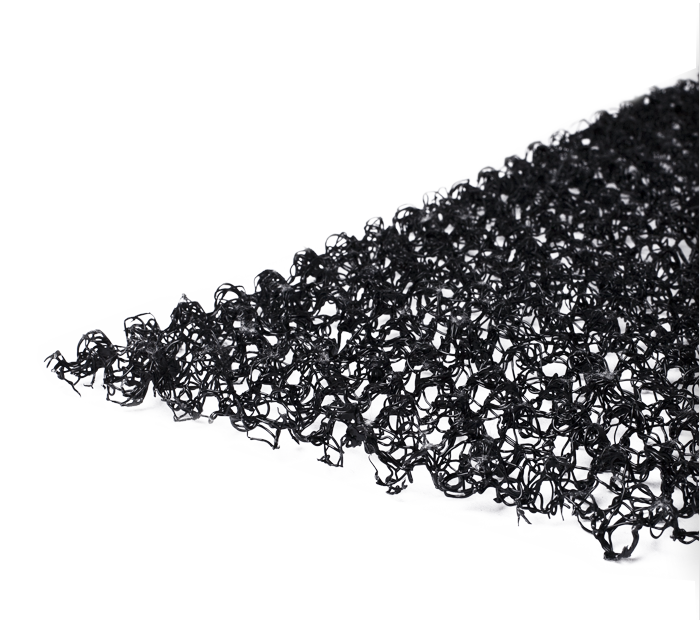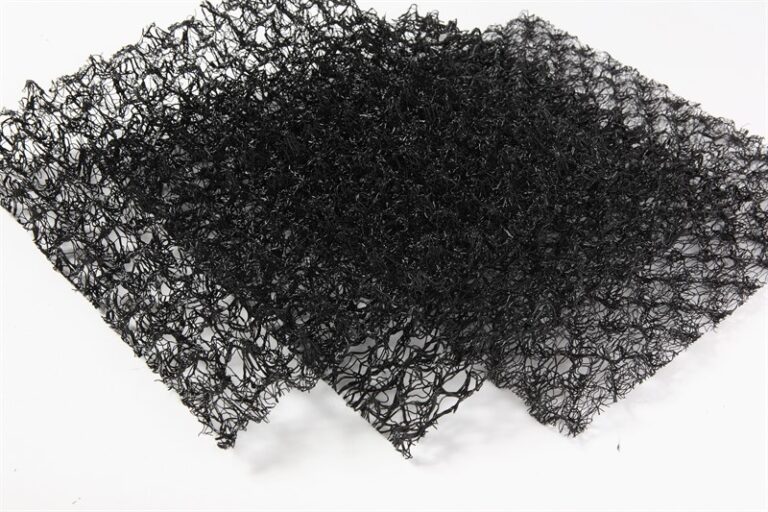Geomats
Geomats, mulch, and erosion control mattresses made from 100% coconut fiber stitched between two PP nets. It provides immediate soil erosion control, protects seeds, and helps establish vegetation growth. It creates the right microclimate for optimum growth conditions.
Geomats are three-dimensional water-permeable polymer or other synthetical materials’ structures, thermally joined with each other. They are used for fixing soil elements, grass and small plant roots also applied in geotechnics and other construction fields. Geomats are produced in the form of honeycombs or other geotextile or plastic band constructions.
Geomats or Erosion control mattresses are applied to create stable vegetation along the river, pond banks, and slopes to prevent erosion processes of surfaces.
Geomats in form of stereoscopic honeycomb constructions are used in combination with geotextiles to reinforce foundations and increase bearing resistance.
Application of bulky geomatics due to the reinforcement of the root system provides long-lasting and eternal erosion control of river and lake banks, slopes and dikes, and surfaces in flooded areas. Due to open surface and strip hardness geometry can be easily filled with soil all over its area and depth, resilient to chemical and biological impact of natural origin, UV resistant, which guarantees a long lifespan of the material.
Geomats are resistant to adverse environmental effects. Open surface encourages root germination, and quick vegetation of slopes and thus guarantees erosion control. Geomats protect slopes and horizontal surfaces nevertheless the soil foundation. With the right choice of material and observation of collecting technique rules, erosion damages can be removed even on difficult areas and steep slopes.
Features Of Geomats
Quick and Easy transport and installation.
A unique circular shape keeps seeds and soil in place while also benefiting vegetation.
Using a more environmentally friendly way to replace shotcrete slope protection engineering.
Applications Of Geomats
Protection from hydro erosion, violation, & landslides in roads
Landscape gardening
Reinforcement of coastline
Reinforcement of slopes, banks, collecting gutters, subgrades
Construction of platforms with natural vegetation
Landscape architecture












FAQ's
Geomats is an eco-friendly solution for preventing soil erosion and ensuring rapid revegetation. Geomats is made of water-permeable synthetic materials like polymer and polypropylene in a three-dimensional pattern. The mats can also be made from a combination of both. Geomats were once only utilised in agriculture, and are increasingly being employed in industrial, business, and residential settings. Because of its long bi-oriented polyethylene construction, these mats are recognized as the future of ground design and layout. Geomats are readily used in geotechnics, construction and many other industries for a wide variety of purposes such as vegetation or soil protection. In residential and industrial applications, these are used to fix grass, small plant roots and soil elements.
Geomats are used in a variety of applications. Some of them are listed below.
– Bare soil and land is protected against soil erosion using geomats.
– These help in fast revegetation.
– Used in areas where grass or bush cover root system is damaged to ensure revegetation.
– If installed before erosion soil erosion can be reduced to 50%.
– Geomats effectively retains water in canals, pipelines, and streams.
– Bare soil and land is protected against soil erosion using geomats.
– These help in fast revegetation.
– Used in areas where grass or bush cover root system is damaged to ensure revegetation.
– If installed before erosion soil erosion can be reduced to 50%.
– Geomats effectively retains water in canals, pipelines, and streams.
The following steps must be followed while installing the geomats:
1) The ground surface of the site must be cleaned.
2) Cut the geomats to the required size and lay them on the cleaned surface.
3) Overlap the geomats and anchor them.
4) Implement slope vegetation for aesthetic purposes.
5) Erosion control with geomats is achieved.
1) The ground surface of the site must be cleaned.
2) Cut the geomats to the required size and lay them on the cleaned surface.
3) Overlap the geomats and anchor them.
4) Implement slope vegetation for aesthetic purposes.
5) Erosion control with geomats is achieved.
There are two types of geomats.
1) Biodegradable geomats – This is a geomat made of natural fibres kept together by two synthetic mats that are separated by a large distance. It is well-known for its capacity to withstand erosive pressures while biodegrading and returning to the soil over time.
2) Photodegradable or Synthetic Geomats – This is a synthetic mat that looks natural, is green in colour, and protects the soil surface from erosion during natural phenomena like rainfall and wind, while also providing some partial shade and heat storage, allowing flora to grow beneath it.
1) Biodegradable geomats – This is a geomat made of natural fibres kept together by two synthetic mats that are separated by a large distance. It is well-known for its capacity to withstand erosive pressures while biodegrading and returning to the soil over time.
2) Photodegradable or Synthetic Geomats – This is a synthetic mat that looks natural, is green in colour, and protects the soil surface from erosion during natural phenomena like rainfall and wind, while also providing some partial shade and heat storage, allowing flora to grow beneath it.

